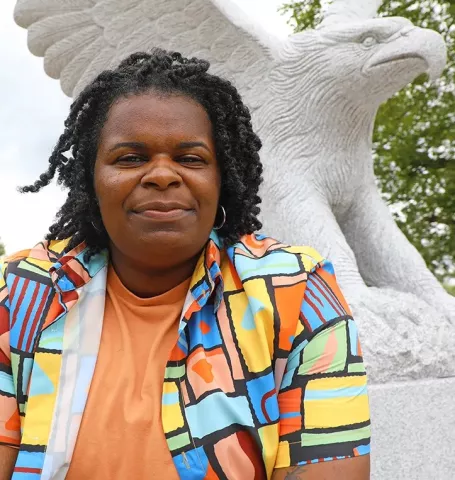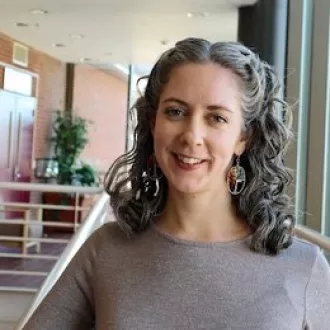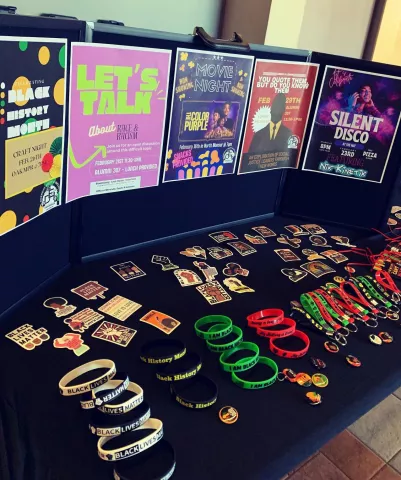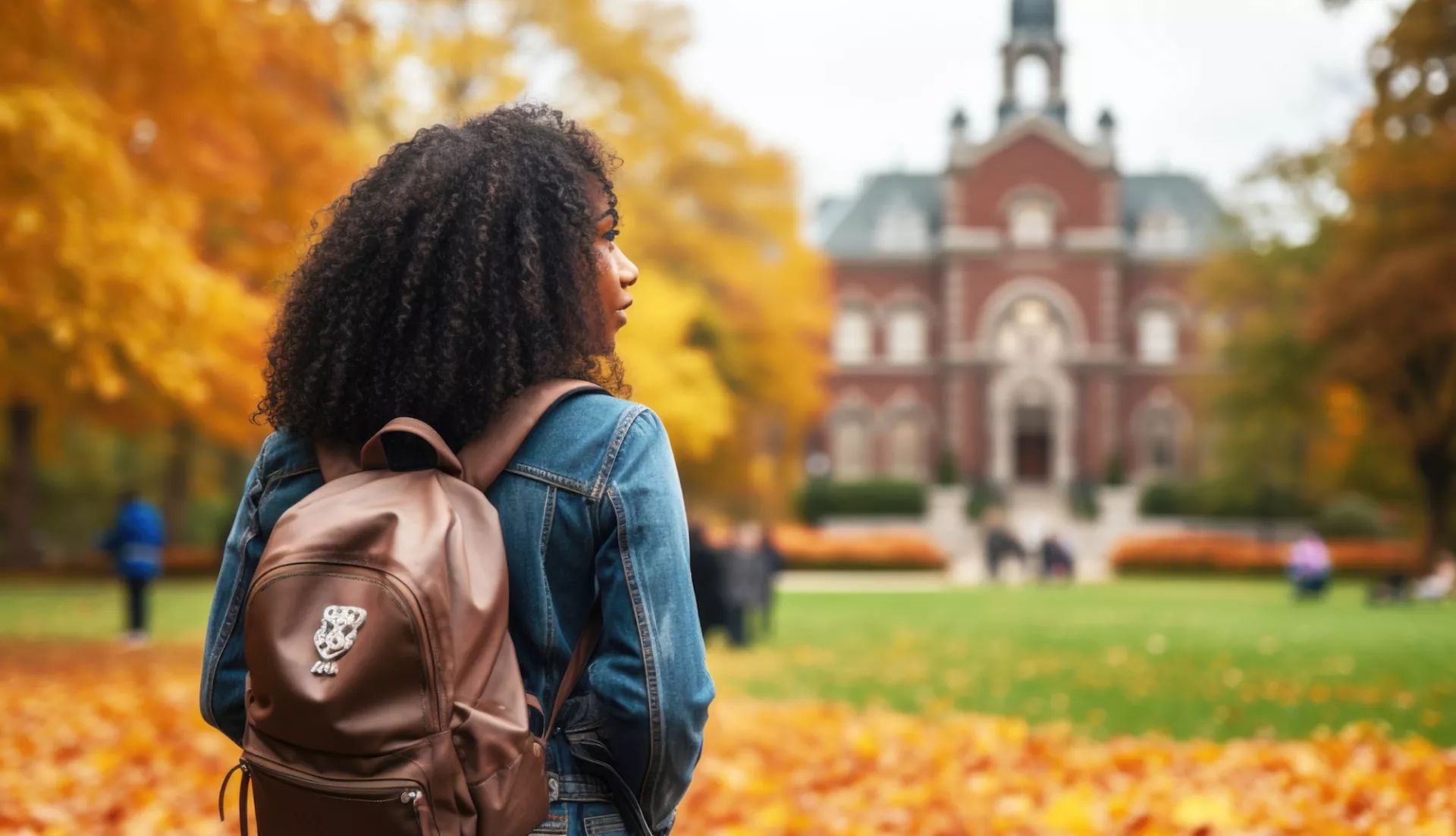Key Takeaways
- DEI supports students and faculty who are historically underrepresented on campuses—that is students of color, military veterans, students with disabilities, and others.
- At least 24 states are weighing anti-DEI bills this spring, many aiming to close multicultural and LGBTQ+ campus centers and forbid employees from providing specific supports.
- Resources provided through DEI help students persist to graduation—and educate everyone on campus about living in a diverse world.
Lock Haven, Pennsylvania, is a lovely little town—emphasis on little—with a Sheetz, a Walmart, “and we just got a Marshalls!” says Mia Swales, assistant director of diversity, equity, and inclusion (DEI) at Lock Haven University (LHU).
Outside of the university, about 8,500 people live here. About 3 percent of them are Black.
So, when students of color come to Lock Haven, it’s often an adjustment. Swales knows this firsthand—because not only is she a Lock Haven employee, she also is an alumna. “If it weren’t for my best friend, I would have gone back home to Maryland,” says Swales, who not only stayed at Lock Haven for her B.A. in 2019 but also a master’s degree in 2022. “She helped me get acclimated and now I’m able to give that back.”

This is the heart of DEI: It’s about creating and sustaining environments that support students and faculty who have been traditionally underrepresented on college campuses, that make them feel safe and welcome—and treat them fairly—after decades of exclusionary practices and policies. This work includes students of color, LGBTQ+ students, military veterans, people with disabilities, those from rural areas or from low-income families, and older adults who work and might have their own children.
“You can call it whatever you want,” says Nichole Book, DEI coordinator at Pennsylvania’s Mansfield University, “but it’s more than any singular thing that people think it is.”
DEI Stands For Diversity, Equity & Inclusion
In many state legislatures, DEI is the latest bogeyman for far-right Republicans, going hand in hand with efforts to ban books with LGBTQ+ characters, to restrict educators from teaching about racism, and to "decrease confidence in public schools," says Education Secretary Miguel Cardona.
"There are very deliberate attempts to seek division in our schools so that a private option sounds better for parents," Cardona told journalists in a roundtable discussion this week. "Four years ago were the masks. [Critical race theory] was a year after that. [Now,] DEI, banning books. Every year, there’s something to stoke division in an attempt to disrupt our public schools and decrease the confidence in our public schools.”
Since 2023, state legislators have introduced at least 65 anti-DEI bills, according to the Chronicle of Higher Education, which would prohibit colleges from having DEI offices or staff; ban mandatory diversity training; ban the use of diversity statements in hiring staff; and ban the use of race or ethnicity in admissions decisions. These four “proscriptions” are the basis of model state legislation that two right-leaning think tanks, the Goldwater Institute and the Manhattan Institute, offered last year, the Chronicle notes.
In six states—Florida, Texas, North Carolina, North Dakota, Tennessee, and most recently, in Utah—they’ve been signed into law. As a result, Florida, Texas, and Utah are closing multicultural and LGBTQ+ centers, shuttering the flow of info and resources on topics ranging from financial aid to sexual assault, and banning college staff from working on those issues.
These bills are a distraction from real education issues, union leaders say. Florida, for example, is still short more than 4,000 teachers, halfway through the school year.
Today, this anti-DEI trend shows no signs of slowing, with at least 50 anti-DEI bills proposed in 20 states such as Arizona, Iowa, Kentucky, Missouri, Nebraska, Oklahoma, and South Carolina, according to the Associated Press. This week, the Kentucky Senate passed its bill, which would ban DEI statements on campus and mandate that every student get a copy of the First Amendment. It goes to the Kentucky House next.
Meanwhile, students of color and LGBTQ+ students—who are the targets of these bills—still have specific needs. In 2022, about 76 percent of the students who entered college in 2021 returned to school. This rate of return is known as the “persistence rate,” and it’s highest among Asian and White students (88 and 80 percent respectively) and lower among Latino students (71 percent), Black students (66 percent) and Native American students (62 percent), according to federal statistics.
The problem? Maybe students of color don’t feel welcome on their campuses. Maybe they’re underprepared by their high schools. Or maybe they just can’t afford it. On average, Black students owe 188 percent more in student debt, four years after graduation, than White students.
Closing Doors, Removing Resources
These anti-DEI bans have resulted in chaos on campuses. At the University of Texas (UT) at Austin, the 10th largest public university in the U.S., the Multicultural Engagement Center shut its doors on January 1. As a result, longstanding UT programs such as “New Black Student Weekend, Adelante, CultivAsian...Latino Leadership Council, Native American and Indigenous Collective, [and] Students for Equity and Diversity,” all have been bulldozed, reported the Texas Observer this week.
UT’s Monarch Center for undocumented students also was shuttered, as was its Gender and Sexuality Center. In its place, the university opened a new Women’s Community Center, which is prohibited from offering LGBTQ+ events or resources. “It’s more than semantics—it’s a resource-based change,” Sameeha Rizvi, former advocacy director of QTBIPOCA, a group that represents and supports UT's LGBTQ+ students of color, told the Chronicle.
Centers oriented to LGBTQ+ students, sometimes known as "Pride" centers, provide safe spaces for students and staff to connect, as well as health resources, ally training, educational panels, campus and community advocacy, and more. This is a dangerous world for LGBTQ+ college students: Last year, about one-third (34%) of college-age LGBTQ+ students reported suicidal thoughts, according to a Trevor Project survey. At the same time, sexual orientation is the second most motivating bias in hate crimes on campuses, according to the National Center for Education Statistics.
(The number-one bias behind campus hate crimes? It’s race.)
And it’s not just UT. At the University of North Texas, the previous multicultural and pride centers also are gone; a new Center for Belonging and Engagement does not mention LGBTQ+ students or students of color, instead focusing on veterans and first-generation students. At UT Dallas, the old DEI office is now “campus resources and support." “If it’s things like mentoring, recruiting and the like, support, we will continue to do those things,” UT Dallas President Richard Benson told Texas Public Radio.
Quote byMonica Johnson , Director of Women's and LGBTQA Resource Centers, Bloomsburg University

It’s Much More Than Events
February is Black History Month, so DEI offices in Pennsylvania’s Commonwealth University, which includes Lock Haven, Mansfield, and Bloomsburg University, are busy with educational lineups, celebratory events, and more.
At Mansfield, the Black Student Union is screening, “The Color Purple,” and the DEI office is offering a few “lunch-and-learns” where all students can discuss race and racism and learn about Black history leaders. “Everybody always throws their quotes up on Instagram in February, but we’ll take it a step further and give it some context,” says Book. “You quote them, but do you know them?”
A spoken-word hip-hop artist is appearing: “That’s someone who is going to present an interesting cultural experience for students that they’re not otherwise going to get [in this town],” says Book.

The point isn’t just to support Black students. It’s also to raise awareness among all students. Many of Mansfield’s students went to all-White high schools in rural Pennsylvania. “This is an opportunity for them, too, to learn what the world looks like,” says Book. Diverse academic settings provide opportunities for advanced learning, she points out.
But the work of DEI officers extends far beyond February events—and far beyond the walls of the multicultural or LGBTQ+ centers they run.
DEI officers like Book and Swales work with admissions officers to attract diverse students to campus, and then develop orientation and retention programs to welcome and support them. They work with faculty, academic advisors, financial aid officers, registrars, and more. "Nine times out of 10, Black and brown students are five steps behind and coming in with two strikes," says Swales. It's her job to level the playing field.
On one hand, DEI officers are talking to students about Parent Plus loans and scholarships, or helping them access on-campus academic services; on the other, they might be responding to complaints about disability discrimination or sexual harassment.
They measure success in graduation rates—but also in ways that are harder to add up. "My best days at work are when I have a students come in here, sit down, and feel safe talking to me," says Swales. "My best days are when I can reaffirm someone, make them feel like they can be successful—that they are successful and are overcoming."
DEI officers who work with LGBTQ+ and women’s centers have the same goals. “We all want [students] to have the best experience while they’re here and to graduate successfully,” says Monica Johnson, who directs the women’s and LGBTQ+ centers at Bloomsburg.
“Creating community for them on campus, helping them to find space where they feel like they belong and are seen, and providing opportunities for education to students who aren’t part of these communities but are supportive and want to learn—in my mind, that’s all part of student success and persistence.”
What Do "Diversity, Equity, and Inclusion" Mean?
*All definitions are from the University of Iowa


